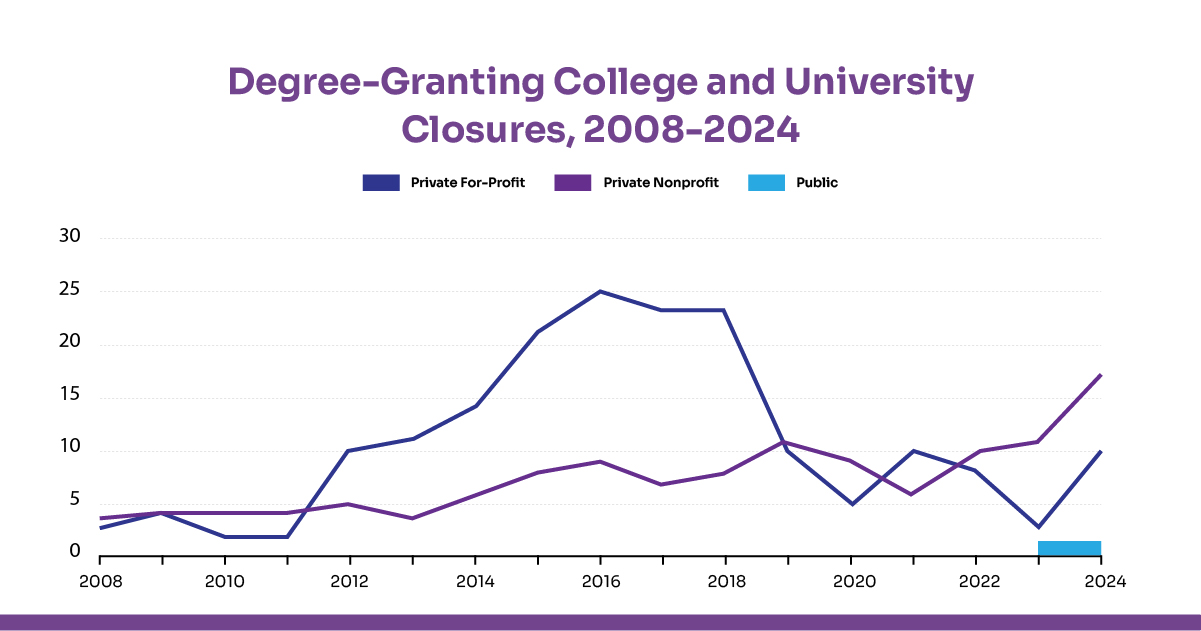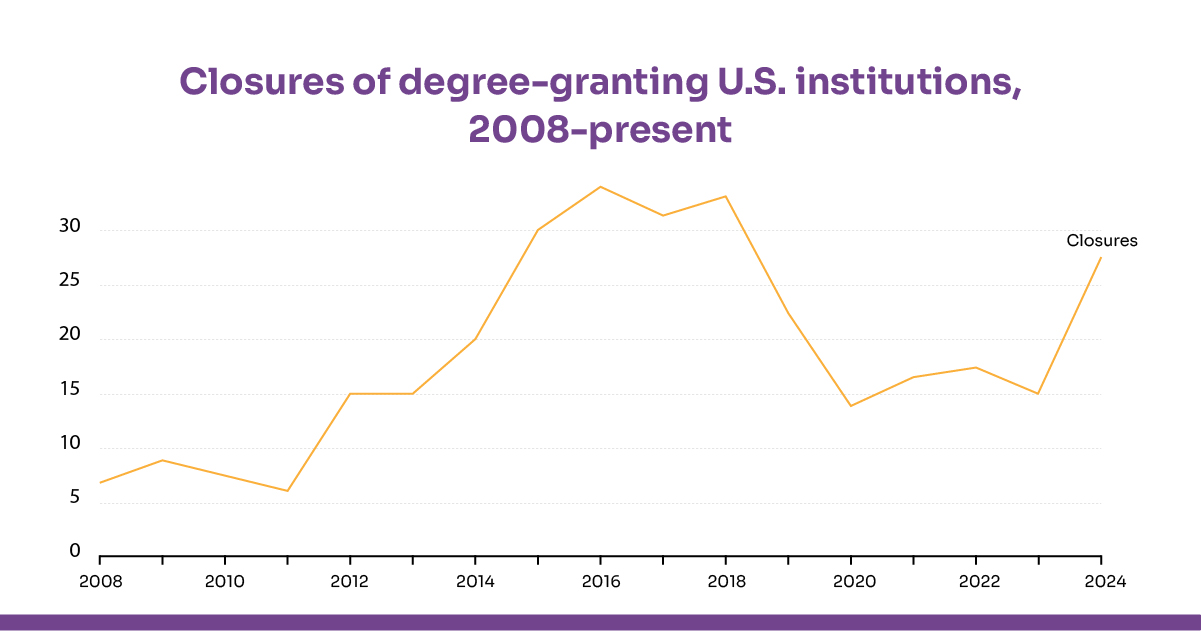College closings are becoming more common due to a mix of challenges, such as financial instability, declining student enrollment, and limited state support. Institutions that fail to adapt to changing educational needs or rely too heavily on tuition are especially at risk. This growing trend highlights the urgent need for innovation and financial planning in higher education.
Table Of Contents
Introduction
The closure of educational programs and entire institutions has become increasingly common in recent years. According to data from the State Higher Education Executive Officers (SHEEO) and The Hechinger Report, around 312 degree-granting colleges and universities shut down between 2008 and 2024. These closures reflect deeper issues such as financial instability, declining enrollment, and shifting educational demands.
For administrators, closing a program or an entire institution involves complex decisions, stakeholder communication, and careful planning. This blog provides practical tips to help education leaders handle college closings smoothly and responsibly.

List of U.S. Colleges Closed in 2024
In 2024, several colleges across the United States shut down due to falling student numbers, financial struggles, and other challenges. Some had been running for over a century, but could no longer survive in the current education environment.
| College Name | Location | Closure Date | Key Reasons for Closure |
| University of St. Katherine | San Marcos, California | Spring 2024 | Bankruptcy due to steep operating cash shortfall |
| Wells College | Aurora, New York | June 30, 2024 | Declining enrollment, inflation, and COVID-19 impact |
| The College of St. Rose | Albany, New York | Spring 2024 | Enrollment dropped by 50% since 2010; fewer high school grads in region |
| Birmingham-Southern College | Birmingham, Alabama | May 31, 2024 | Inability to secure needed funding |
| St. John’s University – Staten Island Campus | Staten Island, New York | April 2024 | Strategic closure; students transferred to Queens campus with aid |
| Hodges University | Fort Myers, Florida | August 2024 | Declining enrollment and financial struggles |
| Lincoln Christian University | Lincoln, Illinois | May 2024 | Financial issues and a declining student base despite cuts |
| Magdalen College of the Liberal Arts | Warner, New Hampshire | May 2024 | Extremely low enrollment (approx. 60 students) |
Key Factors Behind College Closures
More colleges and universities around the world have been closing in recent years. This trend is driven by a mix of financial challenges, falling student enrollments, limited government support, and the inability to adapt to changing educational demands. Here are some of the main reasons behind these college closings.
Financial Mismanagement and Instability
Many colleges have closed due to financial mismanagement, especially in the for-profit sector. These institutions often face sudden shutdowns after losing accreditation or failing to meet financial standards. According to federal data analyzed by the State Higher Education Executive Officers Association (SHEEO), 28 degree-granting colleges closed in just the first nine months of 2024, compared to 15 closures in all of 2023. From 2008 to 2023, nearly 300 degree-granting colleges closed, with over 60% run by for-profit operators. The increasing rate of closures—nearly one per week—shows how financial instability continues to affect higher education institutions across the U.S.

Enrollment Declines
Falling enrollment is a key driver of college closures, especially with the looming demographic cliff. A study by the Federal Reserve Bank of Philadelphia predicts that a 15% drop in enrollment could cause up to 80 additional colleges to close between 2025 and 2029, doubling the current closure rate. Even a gradual decline could raise closures by 8.1% annually, or five more institutions per year. Smaller schools and those already struggling financially are most at risk.
Insufficient or Inconsistent State Funding
Public institutions are vulnerable to reduced state support. For instance, many campuses face funding crises like Peralta Community College in California, which has a $13.5 million budget gap caused by frozen state funds and declining student numbers. Nationwide, Penn State has announced plans to close seven of its 19 branch campuses, impacting over 3,000 students (about 4% of its total enrollment) due to demographic shifts and financial pressures.
Overdependence on Tuition and Donations
Private nonprofit institutions increasingly dependent on tuition and donor contributions face severe exposure when enrollment falls. Since March 2020 alone, at least 81 public or private nonprofit colleges have closed or merged, affecting over 50,000 students. As donors and tuition income weaken, these schools often lack sufficient reserves or alternative support to absorb the shock
Resistance to Change
Colleges that fail to adapt to evolving academic trends and technological innovations face a higher risk of closure. Many institutions still rely on outdated systems and offer programs that no longer align with current industry or accreditation standards. This resistance to adopting tools like AI for enrollment, communication, and curriculum planning can limit flexibility and sustainability. Smaller colleges—especially those with under 1,000 students often lack the resources to modernize quickly. EDMO’s AI-powered platform enables institutions to automate admissions, streamline student communication, and enhance strategic planning helping colleges stay competitive and future-ready.
Things to Consider When Closing an Institution
When a college or university is planning to close, it must undertake a careful, ethical, and legal process to protect the interests of students, staff, and academic integrity. The following key considerations are essential:
Student Support and Teach-Out Plans
- Teach-Out Plans Are Required: Federal law mandates that accrediting agencies approve a teach-out plan if students have not completed their studies.
- Transfer Arrangements: Institutions must help students transfer to other schools by preparing complete academic records and dossiers.
- Financial Aid Transfers: Institutions should coordinate with federal/state agencies to transfer grants. Students must be informed if aid cannot be transferred.
- Scholarship Support: If institutional funds are available, use them to support students completing degrees at other institutions.
Academic Records and Accessibility
- Preserve All Records: Academic and financial aid records must be archived.
- Where to Store Records: Partner with the state education department or another institution for safe, long-term storage.
- Notify Students: Inform all current and past students about where their records are stored and how they can access them.
Completing Degrees After Closure
- Degree Completion Options: Students close to graduation (within 12–18 months) may complete their requirements elsewhere and still receive the degree from the closed institution.
- Legal Status Needed: The college must legally exist and stay accredited for 12–18 months after closure to issue degrees.
- Work With Authorities: Institutions should consult accrediting bodies and state agencies for approval of such arrangements.
Faculty and Staff Support
- Keep Key Staff: Retain essential faculty and staff until closure to help students finish.
- Early Departures Allowed: Allow early resignations if faculty or staff secure other jobs.
- Help With Job Search: Make good faith efforts to support faculty/staff in finding new employment.
Financial Priorities and Final Decisions
- Prioritize Remaining Funds: Use financial resources to meet the essential needs of students and employees first.
- Bankruptcy Consultation: If funds are insufficient, consult legal experts about options under bankruptcy laws.
- Engage Stakeholders: Involve affected parties when deciding how to distribute resources to avoid legal issues.
Final Closure Date
- Board Vote Required: The governing board must formally vote to close the institution and set a final closure date.
- Graduation Options Post-Closure: If degrees will be awarded after closure, legal and accreditation arrangements must be made in advance.
- Assign Decision Authority: Name a person or committee responsible for verifying that students have met degree requirements.
Disposition of Assets
- Follow Legal Rules: Non-profit colleges must follow all state and federal laws when handling or selling assets.
- Honor Donor Wishes: Respect the original intentions of donors when dealing with endowments and scholarships.
- Notify Relevant Agencies: Inform all involved government bodies and financial partners to stay in compliance.
Additional Considerations
- Clear Communication with Creditors: Ensure all agreements with external agencies are settled and documented.
- Avoid Future Legal Risks: Take care to protect the legal standing of student records and institutional commitments after closure.
Following these procedures for college closings helps ensure a smooth, responsible, and transparent process that safeguards the interests of all involved parties.
Tips for Closing Educational Programs
Closing a graduate program is a complex and often emotional process involving numerous stakeholders. Department chairs must approach it with sensitivity, transparency, and a clear plan. Below are structured and practical tips for managing this transition effectively.
Understand Institutional Closure Processes
Program closures are not routine decisions, and each institution has its own set of procedures.
- Do your research: Learn about internal protocols for closing academic programs.
- Check approval requirements: For example, admissions can often be closed at the departmental level, but permanent disestablishment may require higher-level approval, such as from a Board of Regents.
- Know the timeline: Many institutions only process academic closures during specific times of the year.
Example: At Arizona State University, program disestablishments require Board of Regents’ approval and follow a fixed annual timeline.
Prepare Documentation and Justifications
- Collect Required Documents: Compile the necessary forms, rationales, and impact assessments.
- Anticipate Pushback: Be ready to answer difficult questions. Faculty invested in the program may suggest alternatives like increased marketing or curriculum revision.
- Be Respectful: Acknowledge the dedication of faculty who’ve built and maintained the program. Approach conversations with empathy and professionalism.
The University of Queensland announced the phasing out its Master of Museum Studies and Graduate Certificate programs due to persistent low enrollment since 2018. The decision followed internal reviews and collaboration efforts with industry partners.
Manage Admissions Closure Strategically
Closing admissions is often the first operational step:
- Handle Pending Applications Thoughtfully: Decide whether to refund fees for in-process applicants or those recently admitted.
- Coordinate Communication: Clearly assign responsibilities for notifying applicants and guiding them toward alternate programs if available.
- Update Online and Print Materials: Work with marketing teams to reflect the pause in admissions on your website, without removing the program entirely, which could worry current students.
Communicate Proactively with Current Students
Students deserve clarity, reassurance, and support:
- Create a Completion Plan: Offer a transparent roadmap showing when required classes will be available. Outline timelines for thesis or capstone project completion.
- Host Informational Meetings: Encourage students to ask questions and stay informed. Designate a contact person for ongoing support.
- Identify Legacy Students: At many universities, students have up to six years to complete a master’s degree. Proactively reach out to inactive students to discuss re-enrollment options and deadlines.
When the College of Saint Rose announced its closure, it facilitated student transfers through partner institutions like Siena College and University at Albany—allowing dozens to graduate on schedule.
Plan and Publish Course Offerings
Once admission ends, the remaining course delivery becomes critical.
- Schedule the final offerings: Communicate clearly when key courses will be offered for the last time.
- Offer substitutions: Provide alternative options if the final courses overlap or conflict.
Track Progress and Maintain Records
Documentation will be invaluable for internal clarity and audit/back‑reference purposes.
- Archive all communications: Save emails, meeting notes, and memos in a systematic way.
- Maintain a procedural log: Track tasks, approvals, decision dates, and stakeholder outreach in a timeline.
Across U.S. nonprofit colleges, closures have accelerated, with over 80 closures or mergers since 2020 and an estimated 50,000‑plus students impacted. Institutions are increasingly relying on data-rich documentation to manage transitions.
Conclusion
College closings are becoming more common due to ongoing financial pressure, enrollment drops, and changing educational needs. Whether it’s shutting down a single program or managing a full college closure and merger, the process can be complex and emotional.
By planning ahead, involving key stakeholders, and focusing on clear communication, education leaders can handle these changes more effectively. With the right approach, even difficult transitions like college closings can be managed in a way that respects students, staff, and the long-term goals of the institution.









No comments yet. Be the first to comment!
Leave a Comment